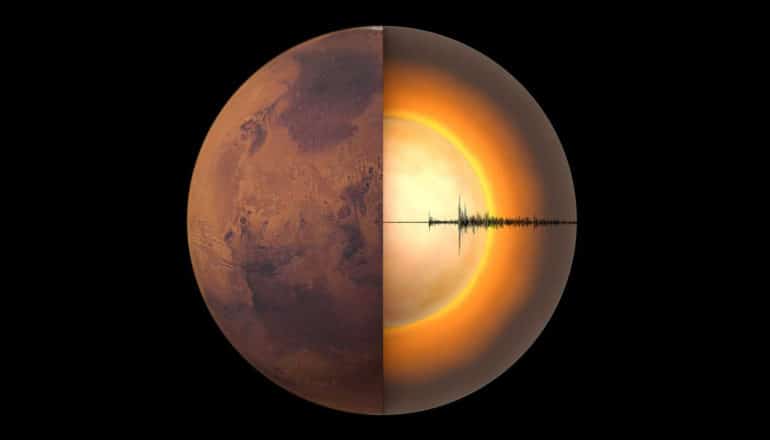
Researchers have used seismic data to look inside Mars for the first time.
They measured the crust, mantle, and core and narrowed down their composition. The three resulting articles (first, second, third) appear together as a cover story in the journal Science.
Since early 2019, researchers have been recording and analyzing marsquakes as part of the InSight mission. This relies on a seismometer whose data acquisition and control electronics were developed at ETH Zurich. The data that will help determine the formation and evolution of Mars and, by extension, the entire solar system.
We know that Earth is made up of shells: a thin crust of light, solid rock surrounds a thick mantle of heavy, viscous rock, which in turn envelopes a core consisting mainly of iron and nickel. Terrestrial planets, including Mars, have been assumed to have a similar structure.
“Now seismic data has confirmed that Mars presumably was once completely molten before dividing into the crust, mantle, and core we see today, but that these are different from Earth’s,” says Amir Khan, a scientist at the Institute of Geophysics at ETH Zurich and at the Physics Institute at the University of Zurich. He and colleague Simon Stähler analyzed data from NASA’s InSight mission, which ETH Zurich participates in under the leadership of professor Domenico Giardini.
The crust, mantle, and core of Mars
The researchers have discovered that the Martian crust under the probe’s landing site near the Martian equator is between 15 and 47 kilometers (9.3 to 29 miles) thick. Such a thin crust must contain a relatively high proportion of radioactive elements, which calls into question previous models of the chemical composition of the entire crust.
Beneath the crust comes the mantle with the lithosphere of more solid rock reaching 400–600 kilometers down—twice as deep as on Earth. This could be because there is now only one continental plate on Mars, in contrast to Earth with its seven large mobile plates. “The thick lithosphere fits well with the model of Mars as a ‘one-plate planet,'” Khan concludes.
The measurements also show that the Martian mantle is mineralogically similar to Earth’s upper mantle. “In that sense, the Martian mantle is a simpler version of Earth’s mantle.” But the seismology also reveals differences in chemical composition. The Martian mantle, for example, contains more iron than Earth’s. However, theories as to the complexity of the layering of the Martian mantle also depend on the size of the underlying core—and here, too, the researchers have come to new conclusions.
The Martian core has a radius of about 1,840 kilometers (1,143 miles), making it a good 200 kilometers (124 miles) larger than had been assumed 15 years ago, when the InSight mission was planned.
“Having determined the radius of the core, we can now calculate its density,” Stähler says.
“If the core radius is large, the density of the core must be relatively low,” he explains: “That means the core must contain a large proportion of lighter elements in addition to iron and nickel.” These include sulphur, oxygen, carbon, and hydrogen, and make up an unexpectedly large proportion. The researchers conclude that the composition of the entire planet is not yet fully understood. Nonetheless, the current investigations confirm that the core is liquid—as suspected—even if Mars no longer has a magnetic field.
Marsquake data
The researchers obtained the new results by analyzing various seismic waves generated by marsquakes. “We could already see different waves in the InSight data, so we knew how far away from the lander these quake epicenters were on Mars,” Giardini says.
To be able to say something about a planet’s inner structure calls for quake waves that are reflected at or below the surface or at the core. Now, for the first time, researchers have succeeded in observing and analyzing such waves on Mars.
“The InSight mission was a unique opportunity to capture this data,” Giardini says. The data stream will end in a year when the lander’s solar cells are no longer able to produce enough power. “But we’re far from finished analyzing all the data—Mars still presents us with many mysteries, most notably whether it formed at the same time and from the same material as our Earth.”
It is especially important to understand how the internal dynamics of Mars led it to lose its active magnetic field and all surface water. “This will give us an idea of whether and how these processes might be occurring on our planet,” Giardini explains. “That’s our reason why we are on Mars, to study its anatomy.”
Source: ETH Zurich
The post Crust, mantle, and core of Mars are quite different from Earth’s appeared first on Futurity.
from Futurity https://ift.tt/3yqADN2
No comments:
Post a Comment